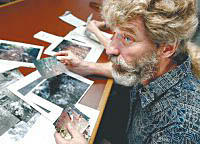Bigfoot Encounters
"Man says Bigfoot took bite from toolbox"
He hopes DNA evidence will stop timber harvest By Tom Lutey, Staff Writer
© The Spokesman-Review.com
--SPOKANE, WA: A Spokane Valley man hopes to stop a Southern Oregon timber
cut in the name of Bigfoot, a creature he said he encountered seven years
ago.
Hobby prospector Karl Breheim insists he ran into the creature while hunting
for gold in the Rogue River area just north of Grants Pass, Oregon.
Breheim believes the beast took a chomp out of his plastic-foam toolbox.
Ever since the encounter, Breheim, 49, has been determined to prove the
mystery mammal is for real. His girlfriend, Nancy Dean Paulson, says the
sighting is no joke. A pending timber harvest has the couple scrambling
for proof. Breheim believes chewed up pieces of his toolbox might hold
the genetic proof needed to declare Bigfoot an endangered species. Now
he needs a scientist willing to test the material.
"I'm the man with the goods," Breheim said. "I don't think
it can hurt someone in Spokane to test these goods." But one of the
nation's top Bigfoot experts, Idaho State University professor Jeff Meldrum,
says there's not enough evidence to prove the encounter was real. "All
I have to go on is what he sent back from his trip. I got this lengthy
letter recounting his experience and two dozen fragments that were buried
under 6 inches of (mulch)," Meldrum said.
"I don't think the chances of recovering DNA evidence from this is
good at all." The anthropology and anatomy professor does find Breheim's
story intriguing. Breheim said he spotted Bigfoot seven years ago in the
Pea Vine area of the upper reaches of the Rogue River drainage. It's the
kind of densely forested area where spotting a 9-foot hairy biped is about
as likely as encountering another human being. The upper reaches of the
Rogue are a hard place to know, say environmentalists who have combed
the area for endangered species, yet hardly covered the forest of which
Breheim speaks.
"It's fairly remote," said Joe Serres, a Grants Pass environmentalist
familiar with Breheim's story. "It's dominated by old growth, Douglas
fir. I give Karl a lot of credit. He's spent a lot of time up there."
Breheim's first trip to the area was prompted by an assayer's book found
in a Spokane Valley home. The book spoke of gold in the Rogue River area.But
what Breheim mostly encountered above the Rogue was unnerving isolation.
The woods were spooky. "In our case, we had visits." he said.
"Things happened in the woods, noises, weird smells. Something big,
something huge was wandering around in the night."
Breheim was certain he was being watched, but hadn't really seen anything.
That changed a few months later when he brought Paulson to the site. The
two worked the site in the day, but drove to Grants Pass at nightfall.
When they returned the next morning, they found close to 50 small trees
snapped "like kitchen matches."
"It seemed to me like a mini tornado had touched down on the trees.
Every one had been snapped off," Paulson said. "That's what
I noticed. Then we saw the bites out of the toolbox and we got out of
there."
Breheim said the bites looked like a giant man had munched a white-bread
sandwich. Pieces of the chewed-up box were spit out 20 feet across the
forest. They stayed on the ground for years beneath ever-piling mulch
until Breheim retrieved them this spring.
There were other signs. Breheim said he found sticks broken to similar
lengths and piled 9 feet high, which he photographed. He found long, steaming
dung samples as big as ship rope. And he found marmots carefully plucked
clean of their fur placed at the doorstep of his camper. And suspicious
shapes in the woods, which Breheim filmed with an infrared camera.
Now Breheim and Paulson are looking for someone willing to do DNA testing
on the chewed up foam. Meldrum, who has studied hundreds of possible Bigfoot
tracks, said the most compelling detail of Breheim's encounter was left
in the woods -- the giant dung piles.
"He tells a very intriguing story. He's related finding nests. He
did show me photos of large debris mounds. No pack rat will build a mound
9 feet tall," Meldrum said. "But I don't see anything there
that would point to sasquatch activity."
Bureau of Land Management employees might have made the stick mounds,
said Abbie Jossie, field manager for BLM's Grants Pass Resource Area.
The BLM has been piling up sticks in the Pickett Snake area of the Rogue
River drainage to reduce fire danger. The area has been contracted for
logging. A second cut in the Pea Vine area will go out on bid this summer.
To date, no one has suggested Bigfoot preservation as a means to stop
a BLM timber cut, Jossie said. That doesn't mean she wouldn't listen if
they did. "If we have a Bigfoot in our woods, we'll definitely do
everything we can to preserve its habitat," Jossie said.
Article
Courtesy Ray Mizer raymizer at webtv dot net
Back
to Newspaper & Magazine Articles
Main
Portions of
this website are reprinted under the Fair Use Doctrine of International
Copyright Law as educational material without benefit of financial gain.
http://www4.law.cornell.edu/uscode/17/107.html
This proviso is applicable throughout the entire website.